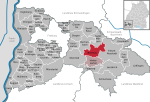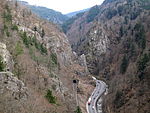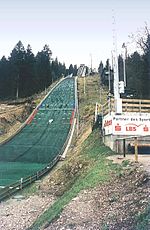St. Oswald's Chapel (Höllental)
12th-century churches in GermanyBuildings and structures in Breisgau-HochschwarzwaldCommons category link is locally definedGothic architecture in GermanyHeritage sites in Baden-Württemberg ... and 2 more
Roman Catholic chapels in GermanyRomanesque architecture in Germany

St. Oswald’s Chapel (German: St. Oswald-Kapelle) lies in the Höllental in the High Black Forest, at its eastern end near the Ravenna Bridge. Administratively it lies in the civil parish of Steig in the municipality of Breitnau in the county of Breisgau-Hochschwarzwald in the German state of Baden-Württemberg. Ecclesiastically it belongs to the parish of Hinterzarten. The chapel is dedicated to Oswald of Northumbria, a 7th-century Anglo-Saxon king. He is depicted in several places on the main altar of the chapel..
Excerpt from the Wikipedia article St. Oswald's Chapel (Höllental) (License: CC BY-SA 3.0, Authors, Images).St. Oswald's Chapel (Höllental)
Höllsteig, Verwaltungsgemeinschaft Hinterzarten
Geographical coordinates (GPS) Address Website Nearby Places Show on map
Geographical coordinates (GPS)
| Latitude | Longitude |
|---|---|
| N 47.9175 ° | E 8.0691666666667 ° |
Address
Sankt Oswald-Kapelle
Höllsteig 80
79874 Verwaltungsgemeinschaft Hinterzarten
Baden-Württemberg, Germany
Open on Google Maps










